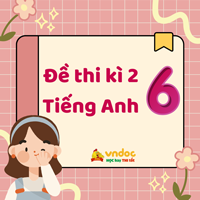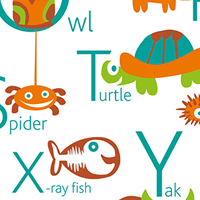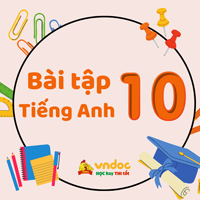Đề thi thử THPT Quốc gia môn Tiếng Anh năm 2018 có đáp án + giải thích chi tiết (Đề số 14)
Đề thi thử Đại học môn Tiếng Anh năm 2017
Hãy thử sức với Đề thi thử THPT Quốc gia môn Tiếng Anh năm 2018 có đáp án + giải thích chi tiết (Đề số 14) này để làm quen với các dạng đề và cấu trúc trong đề thi THPT quốc gia các năm trước để tự tin hơn trong kỳ thi tới. VnDoc.com hi vọng đây sẽ là tài liệu ôn tập hữu ích cho các bạn thí sinh.
Mark the letter A, B, C, or D on your answer sheet to indicate the correct answer to each of the following question.
Question 1: I gave the waiter a $50 note and waited for my____________.
A. change B. supply C. cash D. cost
Question 2: People can become very__________ when they are stuck in traffic for a long time.
A. nervous B. bad-tempered C. stressful D. pressed
Question 3: I believe that judges should be independent_________ the government.
A. to B. from C. with D. on
Question 4: The MP asked__________ the prime minister was aware of the growing social problem.
A. that B. him C. if D. What
Question 5: Although David was___________ household chores.
A. Exhaustion B. exhausted C. exhausting D. exhaustive
Question 6: I think there's a picture of the hotel___________ the first page.
A. on B. at C. in D. to
Question 7: I'm saving all my pocket money___________ to buy a new PlayStation.
A. out B. down C. up D. away
Question 8: We usually do go by train, even though the car____________ is a lot quicker.
A. travel B. journey C. trip D. voyage
Question 9: Dogs make very__________ pets. They'll always stay by your side.
A. mental B. private C. loyal D. digital
Question 10: I'm sorry, but I've got___________ much work to do to come to the beach today.
A. so B. such C. enough D. too
Question 11: - “You must be Jane's sister. Glad to meet you.
“_______________”
A. Iam, either B. So I am. I'm glad C. What do you do D. Me too
Question 12: The boys_____________ that he had had anything to do with the break-in.
A. refused B. denied C. objected D. reject
Question 13: - “How lovely your pets are!”
“______________”
A. Thank you, it's nice of you tosay no B. Really? They are
C. can you saythat again D. I love them, too
Question 14: If you hadn't lost the pieces, we____________ a game of chess
A. couldn'thave had B. can't have C. may have D. could have
Mark the letter A, B, C, or D on your answer sheet to show the underlined part that needs correction.
Question 15: Transplanting organs such hearts and kidneys had proved easier than transplanting muscles.
A B C D
Question 16: On the floor of the Pacific Ocean is hundreds of flat-tipped mountains more than a mile beneath sea level.
A B C D
Question 17: Justice is often personified as a blind folded woman to hold a pair of scales.
A B C D
Read the following passage and mark the letter A, B, C, or D on your answer sheet to indicate the correct answer to each of the question from 41 to 50
The principle of use and disuse states that those parts of organisms' bodies that are used grown larger Those parts that are not tend to wither away. It is an observed fact that when you excercise particular muscles they grow. Those that are never used dimish. By examining a man's body, we can tell which muscles he uses and. which he doesn't, we may even be able to guess his profession or his reaction. Enthusiasts of the "body- building" cult make use of the principle of use and disuse to "build" their bodies, almost like a piece of sculpture into whatever unnatural shape is demanded by fashion in this peculiar minority culture. Muscles are not the only parts of the body that respond to use in this kind of way. Walk barefoot and you acquire harder skin on your soles. It is easy to tell a farmer from a bank teller by looking at their hands alone. The farmer's hands are horny, hardenedby long exposure to rough work. The teller's hands are relatively soft.
The principle of use and disuse enables animals to become better at the job of surviving in their world progressively better during their lifetime as a result of living in that world. Humans, through direct exposure to sunlight, or lack of It, develop a skin color which equips them better to survive in the particular local conditions.
Too much sunlight is dangerous. Enthusiastic sunbathers with very fair skins are susceptible to skin cancer. Too little sunlight, on the other hand, leads to vitamin-D deficiency and rickets. The brown pigment melanin which is synthesized under the influence of sunlight, makes a screen to protect the underlying tissues from the harmful effects of further sunlight. If a suntanned person moves to a less sunny climate, the melanin disappears and the body is able to benefit from what little sun there is. This can be represented as an instance of the principle of use and disuse: skin goes brown when it is "used", and fades to white when it is not.
Question 18: What does the pasage mainly discuss?
A. How the principles of use and disuse change people's concepts of themselves.
B. The changes that occur according to the principle of use and disuse.
C. The way in which people change themselves to conform to fashion.
D. The effects of the sun on the principle of use and disuse.
Question 19: The phrase "wither away" in bold is closest in meaning to
A. split B. rot C. perish D. shrink
Question 20: The word "Those" in bold refers to
A. organisms B. bodies C. parts D. muscles
Question 21: According to the passage, men who body build.
A. appearlike sculptures B. change their appearance
C. belong tostrange cults D. are very fashionable
Question 22: From the passage, it can be inferred that author views body building.
A. withenthusiasm B. as an artistic from
C. withscientific interest D. of doubtful benefic
Question 23: It can be inferred from the passage that the principle of use and dissure enables organisms to
A. changetheir existence B. automatically benefit
C. survive inany condition D. improve their lifetime
Question 24: The author suggests that melanin
A. is necessary for the productionof vitamin-D B. is beneficial in sunless climates
C. helps protectfair-skinned people D. is a synthetic product
Question 25: In the second paragraph, the author mentions suntanning as an example of
A. humans improving theirlocal condition B. humans surviving in adverse conditions
C. humans using the priciple of useand disuse D. humans running the risk of skin cancer
Mark the letter A, B, C, or D on your answer sheet to indicate the word whose underlined part that differs from the other three in the pronunciation in each of the following questions.
Question 26: A. close-knit B. cactus. C. desert D. rhinoceros
Question 27: A. blamed B. dissolved C. misused D. increased
Mark the letter A, B, C, or D on your answer sheet to indicate the word that differs from the rest in the position of the main stress in each of the following question.
Question 28: A. furnish B. reason C. promise D. tonight
Question 29: A. habitable B. infamously C. geneticist D. communist
Read the following passage and mark the letter A, B, C or D on your answer sheet to indicate the correct word for each of the blanks.
THE HISTORY OF WRITING
The development of writing (30) a huge difference to the world and might see it as the beginning of the media. Pieces of pottery with marks on that are probably numbers have been discovered in China that date from around 4000 BC. Hieroglyphics and other forms of "picture writing" developed in the (31) around Mesopotamia (mordem-day Iraq), where the ancent Sumerian civilization was based, from around 3300 BC onwards. However, the first (32) alphabet was used by the Phoenicians around 1050BC. Their alphabet had 22 letters and it is estimated that it lasted for 1000 years. The first two signs were called "aleph" and "beth", which in Greek became "alpha" and "beta" which gave us the modem word "alphabet" The modem European alphabet is based on the Greek and (33) to other European countries under the Romans. A number of changes took place as time passed. The Romans added the letter G, and the letter J and V were unknown to people in Shakespear's time.
If we (34) the history of punctuation, we also find some interesting facts. The Romans used to write quaesto at the end of a sentence in order to show that it was a Question, they started to write Qo in place of the whole word, and then put the Q above the 0. In the end, that became the question mark "?"
Question 30: A. did | B. had | C. made | D. took |
Question 31: A. distance | B. area | C. length | D. earth |
Question 32: A. true | B. accurate | C. exact | D. precise |
Question 33: A. spread | B. appeared | C. was | D. occuưed |
Question 34: A. look into | B. bring on | C. make off | D. hold up |
Đáp án Đề thi THPT Quốc gia môn tiếng Anh năm 2018
1A | 2B | 3B | 4C | 5B | 6A | 7C | 8B | 9C | 10D |
11D | 12B | I3A | 14D | 15A | 16B | 17C | Ỉ8B | 19D | 20D |
21B | 22D | 23C | 24C | 25C | 26C | 27D | 28D | 29C | 30C |
31B | 32A | 33A | 34A | 35C | 36A | 37C | 38D | 39B | 40A |
41B | 42D | 43D | 44D | 45A | 46A | 47D | 48B | 49D | 50D |
Đề thi thử THPT Quốc gia môn Tiếng Anh năm 2018 có đáp án + giải thích chi tiết (Đề số 7)
Đề thi thử THPT Quốc gia môn Tiếng Anh năm 2018 có đáp án + giải thích chi tiết (Đề số 8)
Đề thi thử THPT Quốc gia môn Tiếng Anh năm 2018 có đáp án + giải thích chi tiết (Đề số 15)
Mời các bạn vào tham khảo Đề cương ôn thi THPT Quốc gia năm 2017 môn Tiếng Anh để có một kì thi đạt hiệu quả cao. Chúc các bạn thành công!










